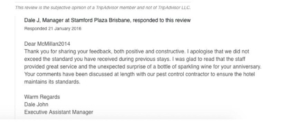Turn that frown upside down: how to make unhappy fans happy customers
Alex Bateman has a successful business. His business took off after a few years of struggle. His peers and contemporaries often asked him, what’s the secret of his success, he told them, “Customer is king”. What really worked for Alex is his constant pursuit of improving his business’ online reputation and turning his customers into happy customers.
No matter how great your services or products are, some of your consumers are bound to run into problems. That’s just the undeniable truth of business — but you can avoid losing your valued consumers because of those issues. It just requires some extra work on the part of your customer support team.
Negative feedback needs to be treated seriously. Whether this feedback comes from your email, a phone call, a social media post, or it’s reported through one of your team members.
The thing that differentiates an average freelancer from a great one is how they respond to unhappy consumers. On that note, we have curated a list of useful tips to satisfy your unhappy consumers and convert them into happy customers.
Table of Contents
Tip #1. Listen and understand what’s really going on
Insights: Being a good listener is a virtue in case of managing your online reputation. This way, you’ll gain a proper understanding of the customer’s issue. Read their messages thoroughly and don’t shy away from asking questions if you need clarity on the issue.
If you find yourself offended by a message, try not to take it personally. You must remember that the consumer approached you because they have an issue they need you to understand.
Their feedback will help the business grow. So, treat this as an opportunity to establish your relationship with your consumer.
For instance, Stamford Plaza Brisbane presents a brilliant example of how consumer complaints should be dealt with. Here’s the snapshot of the response that the management offered when a loyal consumer raised a grievance:

Tip #2. Never forget that your clients are people
Insights: It’s essential to bear in mind through all of your interactions that your clients are real people. Now, this may sound obvious, but when a consumer presents negative feedback or complains about an issue, it’s convenient to see them as a problem to be resolved rather than a person to be helped. And that mindset won’t allow you to provide excellent support.
So every time a client offers feedback, remember that they’re a real individual with a real problem, and do your best to resolve their issue. As a result, you’ll be able to win back unhappy customers.
Tip #3. A heartfelt apology goes a long way
Insights: The ideal way of handling a dissatisfied consumer is, to be honest, and apologetic. When you acknowledge the mistake and convey that you are genuinely sorry about the inconvenience of the consumers, you can change their attitude in your favour. People tend to appreciate honesty and an apology is often the outcome they were hoping for.
 Whether there is misinformation on your site, a late deadline or some other issue entirely, recognising the mistake is the most crucial step to satisfy your unhappy client. You can assure them that you’ll take proper steps to rectify the error. This way, the consumers will be able to continue availing of your service and associate with your brand in the future. Imagine, you have an academic writing service, and a student approached your company with concern after seeking perfect essay help. In this case, you need to address the concern with an apology.
Whether there is misinformation on your site, a late deadline or some other issue entirely, recognising the mistake is the most crucial step to satisfy your unhappy client. You can assure them that you’ll take proper steps to rectify the error. This way, the consumers will be able to continue availing of your service and associate with your brand in the future. Imagine, you have an academic writing service, and a student approached your company with concern after seeking perfect essay help. In this case, you need to address the concern with an apology.
Tip #4. Empathy is a virtue that should be extended
Insights: It’s essential for you to put yourself in the client’s shoes to understand their predicament. However, it isn’t unusual for the support team of an agency to rush through an explanation to resolve the issues highlighted by the consumers. And while this may be the quickest way to know what’s going on, it’s not the most effective.
So, it’s imperative to begin every interaction by listening actively and attempting to fully understand the customer’s perspective before offering a solution. Focus on meeting the needs of the consumers— and make it a priority over merely offering the right answer.
When it comes to showing empathy, you must make sure to convey it appropriately through words. Here are some approaches you should take while communicating-
- “It is understandable how frustrating it is when…”
- “We know how confusing it must be when…”
- “I imagine how upsetting it is to…”
- “I realise how complicated it is to…”
Tip #5. Customise your approach to each customer
Insights: You must acknowledge the fact that each of your consumers is different.
 Now, even though many of their problems may be similar, it’s likely that the best approach to solving them may differ. This means you should refrain from using canned, generic responses. Even if the solution itself is relatively straightforward, you have to ensure that the consumer feels acknowledged and understood.
Now, even though many of their problems may be similar, it’s likely that the best approach to solving them may differ. This means you should refrain from using canned, generic responses. Even if the solution itself is relatively straightforward, you have to ensure that the consumer feels acknowledged and understood.
Taking 30 seconds or so extra to address them by name and present a unique response can go a long way in attaining this goal and boost the consumer’s overall experience with your brand.
Tip #6. Negative language is a strict no-no
Insights: Always make it a point to use a positive tone and avoid negative language. Every sentence you write (or speak) should reflect that you regret the inconveniences caused by a particular issue. The idea is to evoke positive emotions with your language.
You should employ positive language throughout in order to counter a negative reaction. Always show that you value their opinion. For instance, you might say, “Please let me know if there is anything else I can do to help turn your experience into a positive one.” This is a sure-fire way to happy customers.
Tip #7. Never leave any opportunity to satisfy the client
Insights: Once you’ve resolved a consumer’s immediate issue, you might perceive that your job is done.
But it’s not always safe to think that fixing the issue at hand is enough. Rather you should always ask each customer whether they’re satisfied with the resolution you’ve offered them.
This way, you can also look into any other concerns they might have. Only then, you can be confident that you’ve provided the level of service they were looking for.
Tip #8. Following up is crucial
Insights: In many cases, you may not be sure if a consumer’s issue was completely resolved during an interaction. But you shouldn’t wait for them to get in touch and tell you that the problem still hasn’t been fixed.
So, take a proactive approach and follow up with each of the consumers. One of the best ways to do this is with a simple email.
“Hi April,
Hope you’re doing well.
Please let us know if the issue bothers you again. I’d be available to help you.
If you have any other queries, just let me know, and I’ll be glad to assist you in any way I can. Have a great day!
Justin”
This kind of response highlights that you care about customers’ experiences — and that you didn’t forget about them the moment your interaction ended.
Parting thoughts,
Your business can thrive only when your consumers are satisfied. So, it’s important to seek constant feedback from them. And in case of negative feedback, you have to be extra careful in order to satisfy the consumers. This is when employing these tips are going to work out well.
Continue Reading: How to Expand Your Freelance Portfolio and Gain More Clients
Author bio:
William Shell a Writer and Enthusiastic blogger. He is also associated with a reputed company for the past couple of years. Here, he delivers quality dissertation help to students on their requests. Besides being an active blogger, he loves to travel around the world.



 Clients-copywritercollective
Clients-copywritercollective
